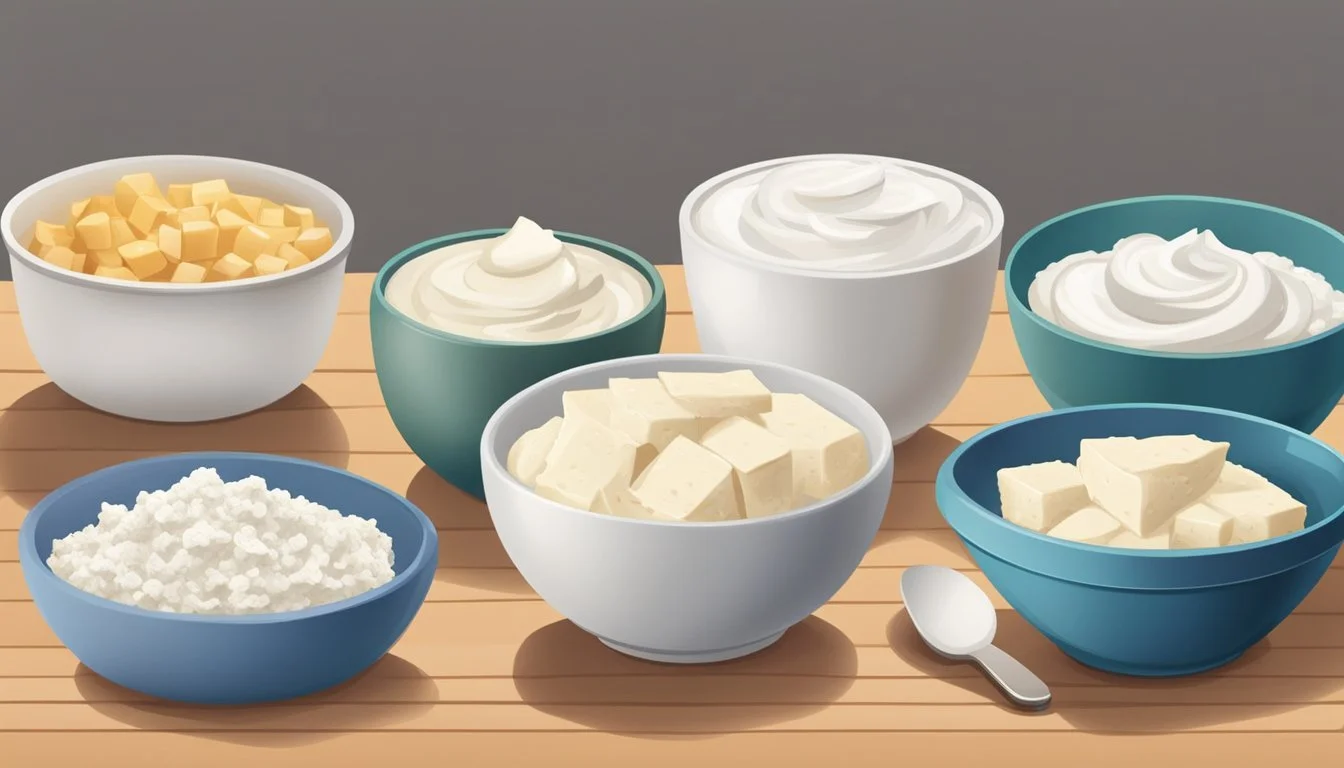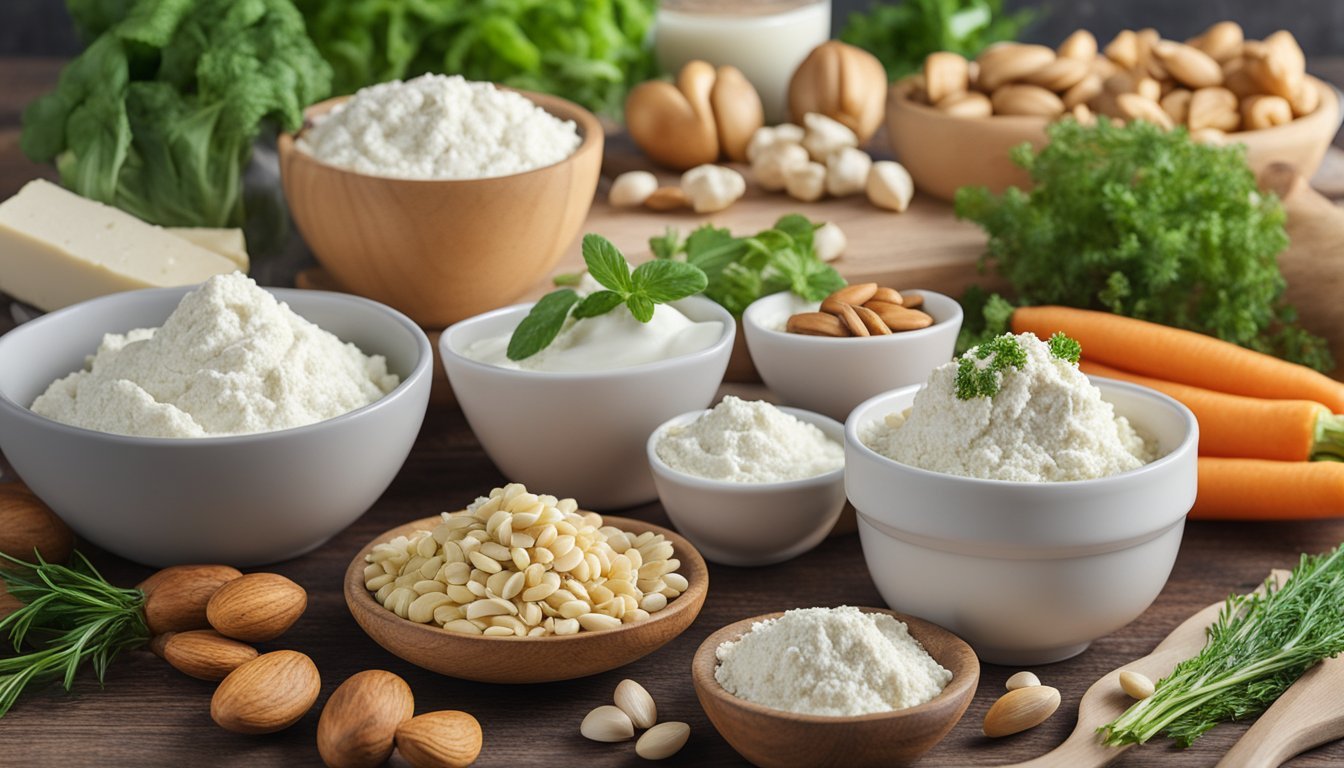Ricotta Cheese Substitutes
Top Alternatives for Your Recipes
Ricotta cheese (What wine goes well with cheese?), with its light texture and subtle sweetness, is a staple ingredient found in a variety of recipes ranging from lasagna to cheesecake. Its distinctive characteristics stem from the way it's made—ricotta is traditionally produced by reheating the whey leftover from the production of other cheeses. When cooking or baking demands ricotta and there's none on hand, or when dietary restrictions call for an alternative, finding a suitable substitute can be crucial for the success of a dish.
Fortunately, a number of other cheeses and dairy products can fill in for ricotta, either as a direct stand-in or with minor adjustments to the recipe. Cottage cheese is often recommended as a substitute due to its similar texture, and when blended until smooth, it closely mimics ricotta's creaminess. Slightly tangier cheeses like cream cheese can also be used, particularly in recipes that can accommodate a denser texture and a richer profile.
For those looking for a non-dairy or vegan alternative, several plant-based options exist that can mimic the texture and flavor profile of ricotta. It's important to consider the end goal of the dish being prepared, as some substitutes may lend themselves better to sweet applications, while others excel in savory dishes. Despite the differences in flavor and texture, these substitutes can be successfully used to recreate dishes that traditionally rely on ricotta, ensuring that the essence of the recipe is preserved.
Understanding Ricotta Cheese
Before delving into alternatives, it is essential to understand the unique qualities of ricotta cheese and its role in culinary traditions. This section will explore the characteristics, cultural significance, and nutritional aspects of ricotta cheese.
Characteristics of Ricotta
Ricotta is a soft, fresh Italian cheese with a grainy texture and a mild, slightly sweet flavor. It's made from whey, a by-product of cheesemaking, which is reheated and coagulated to form the cheese. Ricotta can come from the milk of cows, sheep, goats, or Italian water buffalo. The texture is creamy and moist, making it a versatile ingredient in various dishes.
Role in Italian Cuisine
Ricotta cheese holds a significant place in Italian cuisine. It is a central ingredient in a plethora of Italian dishes ranging from appetizers to desserts. Its delicate taste and fluffy texture make it perfect for classic recipes like lasagna, ravioli, and cannoli. Ricotta's versatility extends to its use in spreads, fillings for pastries, and even as a complement to fresh fruit.
Nutritional Profile
The nutritional value of ricotta cheese can vary depending on the source of milk. Here's a basic nutrient breakdown for a typical serving:
Nutrient Amount per 100g Calories Approximately 174 kcal Protein 11.3g Fat Content 13g Calcium High
Ricotta is a good source of protein and is rich in calcium. While it is relatively high in fat content and calories, ricotta can be part of a balanced diet, especially when opting for variants made from skim milk.
Why Substitute Ricotta?
Many individuals find themselves seeking alternatives to ricotta cheese for various reasons ranging from dietary constraints to personal taste preferences. The need for substitutes may arise when individuals are dealing with lactose intolerance, adhering to a vegan lifestyle, or simply when ricotta is not available.
Dietary Restrictions
Lactose Intolerance: Ricotta cheese is a dairy product that contains lactose, which can cause digestive issues for those who are lactose intolerant. They may experience symptoms such as bloating, gas, and discomfort, prompting the need for a non-lactose alternative.
Vegan: Vegans abstain from all animal products, which includes ricotta cheese. Vegan substitutes for ricotta are often plant-based and designed to mimic the cheese's texture and flavor without using any animal-derived ingredients.
Texture or Flavor Preferences
Some individuals may prefer a different texture or flavor profile in their dishes. Ricotta has a distinct texture and taste that might not align with everyone's preferences. Substitutes can offer different consistencies and flavors that may be more suitable for certain recipes or palates.
Availability
Ricotta cheese may not always be readily available in all regions or stores. When it's lacking on the shelves, cooks may need to use an alternative that's more accessible. Availability of substitutes can depend on the location and might influence which option is selected.
Dairy-Based Ricotta Alternatives
When searching for a ricotta substitute, dairy-based alternatives provide the closest match in terms of flavor and texture due to their creamy profiles and similar fat contents. Here are several options suitable for various dishes, whether they require baking, filling, or spreading.
Cottage Cheese
Cottage cheese stands out as the a close match to ricotta with its slightly tangy flavor and similar granular texture. For a smoother consistency, blending before use is recommended. This cheese is particularly suitable for fillings and baked dishes.
Cream Cheese
Cream cheese is another fine substitute, especially for dishes that require a spreadable or creamy texture with a higher fat content. Its rich profile works well in sweet and savory recipes.
Mascarpone
With its indulgent, buttery flavor, mascarpone offers a decadent alternative to ricotta. It’s ideal for desserts and can add a creamy element to sauces or dips.
Greek Yogurt
Greek yogurt can replace ricotta for a healthier twist due to its high protein and lower fat content. It has a tangy kick and thick texture, making it great for dips and spreads.
Queso Fresco
Queso Fresco, a mild and tangy fresh cheese, offers a crumbly yet creamy consistency. It works well as a topping or filling, particularly in savory applications, but one must consider its saltier profile.
Fromage Blanc
The creamy, soft cheese known as fromage blanc is likened to ricotta for its smooth texture. It’s suitable for both savory and sweet recipes and can seamlessly substitute ricotta in most recipes.
Paneer
Paneer, although non-traditional, can be used crumbled or mashed as a ricotta replacement. It offers a mild flavor that absorbs the essence of accompanying ingredients, making it versatile for various culinary uses.
Mozzarella
Low-moisture mozzarella, when finely shredded, can mimic ricotta’s texture in baked goods. Its meltability makes it a viable option for lasagnas and stuffed pastas, though it lacks the classic tang of ricotta.
Non-Dairy and Vegan Substitutes
When seeking to replace ricotta cheese in various recipes, individuals with lactose intolerance or those following a vegan lifestyle have several non-dairy alternatives that closely mimic ricotta's creamy texture and mild flavor. These substitutes also offer protein content, essential for many diets.
Tofu Alternatives
Tofu, particularly the firm silken variety, is a popular base for vegan ricotta cheese. Due to its protein content and versatility, tofu can be blended to a creamy consistency. For a savory touch, adding lemon juice and nutritional yeast can closely emulate ricotta's flavor profile.
1 package of firm silken tofu
1 tablespoon of lemon juice
2 tablespoons of nutritional yeast
Blending these ingredients yields a substitute that is both dairy-free and suitable for lasagna or stuffed shells.
Nutritional Yeast and Seasonings
Nutritional yeast is a staple in vegan cooking, offering a cheese-like flavor because of its natural umami properties. When combined with seasonings such as garlic powder and salt, it enhances almond flour or cashew-based ricotta substitutes to offer a dairy-free alternative with added protein and B vitamins.
1/2 cup of almond flour or soaked, drained cashews
1/4 cup of nutritional yeast
1/2 teaspoon of garlic powder
Pinch of salt
Coconut Cream
Coconut cream provides a rich and creamy substitute with a subtle sweetness, making it excellent for desserts or sweet dishes requiring ricotta. It is high in healthy fats and gives a unique, slightly tropical flavor to the final dish. One can use it as a one-to-one substitute for ricotta in sweet applications.
Equivalent for 1 cup of ricotta:
1 cup of coconut cream
This replacement should typically be reserved for dishes where a hint of coconut will complement the other flavors.
Soy Yogurt
For those looking for a lighter consistency, unsweetened soy yogurt can serve as a ricotta cheese substitute, especially in dips and spreads. Its creamy texture and high protein content make it an ideal dairy-free option that pairs well with herbs and spices for savory preparations.
To achieve a ricotta-like texture:
Strain the soy yogurt through a cheesecloth or fine mesh to remove excess liquid.
With the right seasonings, soy yogurt can be transformed into a flavorful and health-conscious alternative to traditional ricotta.
Versatile Substitutes for Specific Dishes
When looking for ricotta cheese alternatives, it's essential to match the substitute's flavor and texture profiles to the original recipe's requirements. Here, specific substitutes are tailored for distinct types of dishes from baked pastas to desserts.
Substitutes for Baked Pasta Dishes
For dishes like lasagna and stuffed pasta, a substance with a similar creaminess and fat content is vital. Cottage cheese, strained through a cheesecloth to remove excess moisture, mimics ricotta's texture well. Adding a bit of cream and blending until smooth can enhance the mouthfeel. Bechamel sauce is also an excellent option for layering, lending creamy richness without altering the dish's structure.
Alternatives for Desserts and Sweet Recipes
In desserts such as tiramisu, cannoli, or cheesecake, a substitute must provide creaminess as well as a balanced flavor. Mascarpone has the lush fat content and indulgent texture ideal for sweet applications. Its subtle sweetness works beautifully in desserts where ricotta would normally provide a delicate flavor. For a lighter option, Greek yogurt can be used, though some sweetness may need to be added.
Substitutes for Salads and Lighter Fare
Salads often require a lighter, more crumbly cheese that won't overpower the other ingredients. Queso fresco or feta cheese, with their fresh and tangy qualities, can be crumbled atop salads as a stand-in for ricotta, providing a similar flavor profile with added saltiness. They should be used sparingly to maintain balance in the dish.
Cheese Alternatives for Toppings and Fillings
The cheese used for toppings or fillings in items like pizza and savory pastries needs to melt well and offer a pleasing mouthfeel. Mozzarella is a fantastic substitute for its stringy, meltable qualities, while ricotta's mildness is echoed in paneer, especially when crumbled. Cream cheese can be thinned with milk to achieve a suitable consistency, especially for fillings where a dense texture is not desired.
Practical Tips for Substituting Ricotta Cheese
When switching out ricotta cheese, focusing on texture and flavor ensures the substitute matches the intended profile of the dish. Here are practical considerations for successful replacements.
Considering Fat Content and Creaminess
To maintain a dish's integrity, matching the fat content and creaminess of ricotta cheese is essential. Ricotta has a unique, creamy texture that's not too dense, making it ideal for both sweet and savory dishes.
Cottage Cheese: This cheese shares a similar texture with ricotta. For a creamier outcome, it may be blended until smooth.
Cream Cheese: Offering a denser consistency, cream cheese can be used 1:1 for ricotta. However, to achieve a closer match to ricotta's lighter creaminess, one might mix in a bit of milk or cream.
Balancing Flavor and Seasoning
Substitutes may alter the flavor profile of a recipe, so seasoning adjustments are often necessary. One should be mindful of the tanginess and inherent taste of the alternate cheese.
Queso Fresco: Known for being mild and tangy, it's suitable for savory dishes but may require reduced seasoning due to its saltiness. Adding water could aid in achieving the desired moisture.
Sour Cream: Its tangy nature can offer a flavorful alternative in recipes where ricotta's mildness isn't pivotal.
Substitute Quantities and Ratios
Using substitutes in precise quantities preserves the balance within a recipe. Maintaining the correct ratios will ensure that the dish's texture and structure remain consistent.
Substitute Quantity Ratio Notes Cottage Cheese 1:1 Blend for extra smoothness. Cream Cheese 1:1 Add milk or cream to adjust consistency. Queso Fresco 1:1 May need water and less seasoning. Sour Cream 1:1 or to taste Useful in non-critical ricotta flavor applications.
Observing these points when choosing and using a substitute for ricotta cheese helps in keeping the essence of the original recipe alive while making necessary modifications.
Making Homemade Ricotta Substitutes
When one can't acquire ricotta or prefers a homemade touch, they can create a substitute from common kitchen staples such as milk, cream, vinegar, or lemon juice. The texture and taste can be tailored by choosing different ingredients and methods.
Using Milk and Cream
One can simulate the creaminess of ricotta by combining milk and cream. They would heat the milk to near-boiling and then add cream to enrich the mixture, creating the necessary fat content for a smoother texture. The process involves:
Heat 4 cups of milk to 185°F, stirring frequently to prevent scorching.
Reduce the heat and add 1 cup of cream, mixing gently.
Proceed to the curdling stage as outlined in the "Alternative Methods with Vinegar or Lemon Juice" subsection.
This method yields a homemade substitute that approximates the richness and texture of ricotta.
Alternative Methods with Vinegar or Lemon Juice
Should someone wish to curdle their milk and cream mixture without specialized ingredients, vinegar or lemon juice act as accessible coagulants. The steps outlined below guide the user through creating curds, which can then be strained and processed to achieve a ricotta-like consistency:
Gently stir in 2 to 3 tablespoons of white vinegar or fresh lemon juice per 4 cups of the heated milk and cream mixture.
Allow the mixture to sit undisturbed for 10 minutes; curds will form.
Pour the curds into a sieve lined with a cheesecloth set over a bowl to drain.
For a smoother texture, one could transfer the curds to a food processor and pulse until the desired consistency is achieved.
By following these instructions, a cook can prepare a homemade cheese that closely resembles ricotta in both taste and texture.





